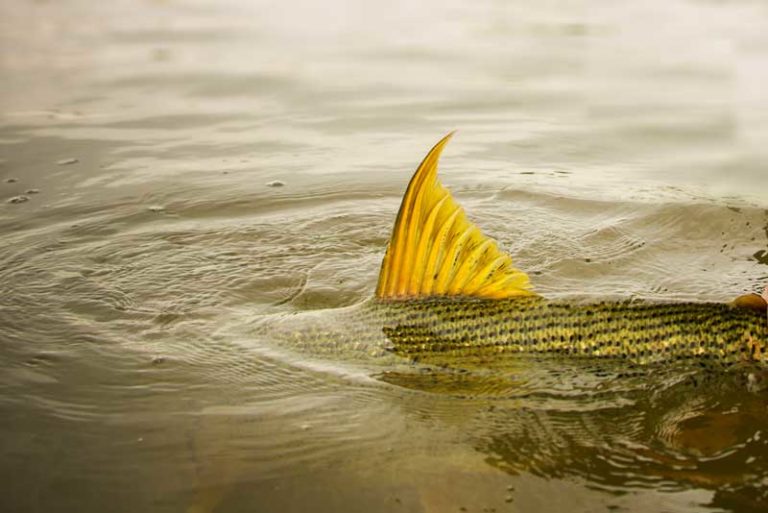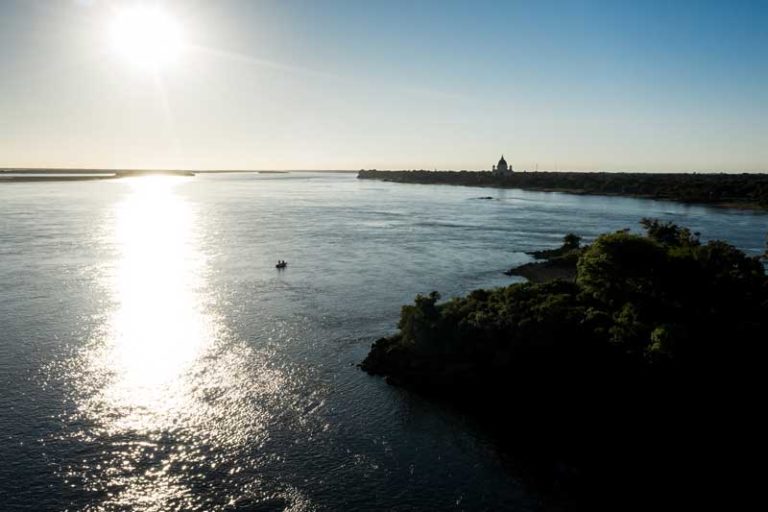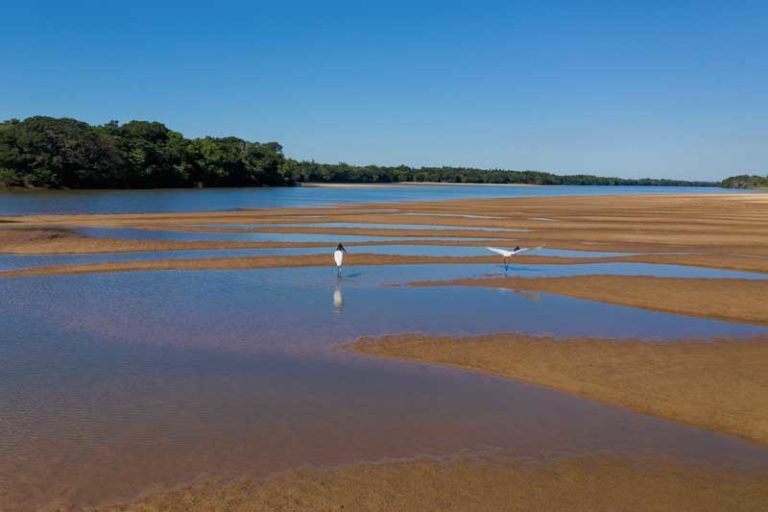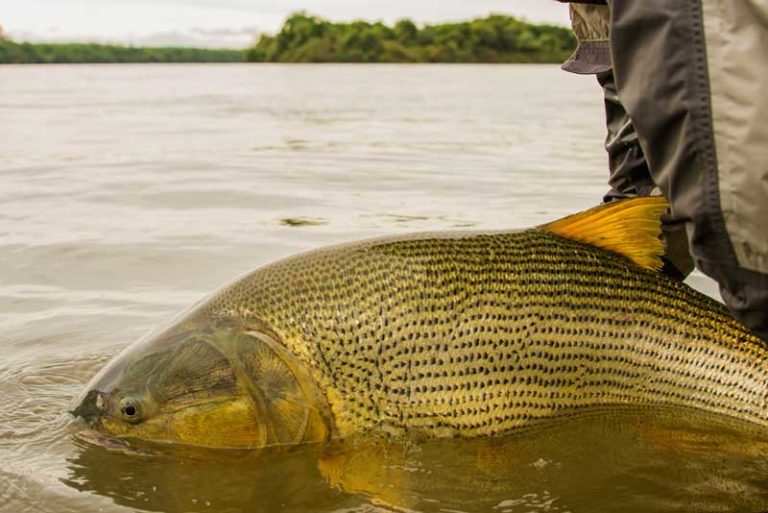Golden Dorado
Spawning Season

A Great Dorado Migration

Uniquely - Dorado Spawning
The spawning location is carefully chosen, water with enough velocity and turbulence in the current to increase the probability that eggs will be introduced to the sperm of several different males. If the water is too slow, the eggs will sink to the bottom unfertilized and perish.

The Natural Beauty of Floods

From Small to Legendary Giants
Other golden dorado articles
After 20+ years of fly-fishing and numerous destination trips, we were ready for our next adventure; “Big Yellow Toothy Fish”—Golden Dorado in Argentina!We booked a trip through an unfamiliar (to us) outfitter called SET Fly Fishing. Soon after, COVID stopped…
The common theme of conversation among guides and fishing friends, often while sitting around a campfire or gathered at a winter Asado, is always about fishing. And when the subject turns to Golden Dorado, the recurring question posed to the…
It's Official After two years of severe drought and unprecedented conditions across northeastern Argentina, which created some challenges and puzzles to find the best Golden Dorado fishing, water conditions have now recovered. Since October of 2022 the entire Parana River…
Explorations and New Fisheries Scouting keeps us going Presenting jetu'u Cabaña de Esteros Home waters are always special. They are the place you’ve known for a long time, and have come to learn every intimate detail. You’ve spent many hours…
For those who love adventure on the water, Jetu'u Lodge offers more than just exceptional fly fishing; it invites you to explore a rich cultural tradition deeply rooted in Argentina. Located near the serene landscapes from Santa Lucia to Esquina…
Catch-and-release can be an effective way to reduce impacts on recreationally targeted species, however just claiming “I already practice catch-and-release” isn’t good enough. There is a growing body of science that shows that how an angler fights, handles, and releases…
The first half of the Golden Dorado season at our lodges was nothing short of spectacular. Between September and December 2024, we welcomed 163 guests to our Golden Dorado lodges, and together we landed an impressive 5,441 Golden Dorado. That’s…
We understand that every angler is unique, with their own vision of the perfect fishing adventure. That’s why we’re excited to guide you to the best locations in Argentina for Golden Dorado fishing—places that are not just about the fish,…
Imagine waking up to the sound of rippling waters, the fresh air filling your lungs, and the excitement of a fishing adventure waiting for you. For most, the saying "A bad day of fishing is always better than a good…
Golden dorado are an iconic fish species of Neotropical watersheds. They are fierce predators that likely play an important ecological role in the waters they inhabit. Of course, their explosive strike, leaps, and beautiful colors put them on the bucket…
The thrill of fooling Golden Dorados with flies lies in the incredible visual action we witness with every strike, whether using a streamer fly or a topwater fly pattern. To succeed in catching Golden Dorado, our expert guides have curated…
For the past few years, a heavy heart hung over us at Set Fly Fishing. The once-majestic Ibera Wetlands, a haven for anglers and a vital ecosystem, had fallen victim to a historic drought. The lifeblood of the region dwindled,…
This question used to be a simple one to answer. Now, with the 3 separate destinations available in the Golden Dorado Experience it’s a bit more complex, but worth studying because of the variety of conditions where you can target…
Hi friends! We are finishing another fabulous spring Dorado season and this time with an extended Golden Dorado Experience, the first one after the inclusion of Jetu'u Cabanas de Esteros to the family of our lodges. And, there were many…
Some of you may now; Rachel Finn has been an ambassador and great friend for SET for several years now. She has been hosting groups regularly to all our lodges for golden dorado and trout.Last year we had the opportunity…
Also known as “Carlitos”, he has been a part of The Golden Dorado Experience since the beginning. He has accumulated more hours on the water chasing Dorados than any guide could wish for, and his knowledge about the species and…
The Golden Dorado Experience by SET Fly Fishing was recently completed with the addition of a third lodge, Jetu’u Cabañas de Esteros. But given that the lodges are all within a 55-minute flight of each other, some might wonder how…
I was lucky to be born and raised near the largest tributary of the La Plata basin, the beautiful Parana River. In my early teens my friends and I started fishing, first with conventional tackle and live bait, then artificial…
The Paisanos of the Ibera have survived for many generations in an intimate relationship with the land and waters of this beautiful ecosystem, making their living raising cattle and farming in family groups.In Argentina, the name “Paisano” was originally used…
At SET Fly Fishing we are always planning your next great adventure. From the beginning, we have been a team of passionate anglers and hardcore explorers with a vision - to bring the most exciting and adventurous fishing vacations to…
After 20+ years of fly-fishing and numerous destination trips, we were ready for our next adventure; “Big Yellow Toothy Fish”—Golden Dorado in Argentina!We booked a trip through an unfamiliar (to us) outfitter called SET Fly Fishing. Soon after, COVID stopped…
The common theme of conversation among guides and fishing friends, often while sitting around a campfire or gathered at a winter Asado, is always about fishing. And when the subject turns to Golden Dorado, the recurring question posed to the…
It's Official After two years of severe drought and unprecedented conditions across northeastern Argentina, which created some challenges and puzzles to find the best Golden Dorado fishing, water conditions have now recovered. Since October of 2022 the entire Parana River…
Explorations and New Fisheries Scouting keeps us going Presenting jetu'u Cabaña de Esteros Home waters are always special. They are the place you’ve known for a long time, and have come to learn every intimate detail. You’ve spent many hours…
For those who love adventure on the water, Jetu'u Lodge offers more than just exceptional fly fishing; it invites you to explore a rich cultural tradition deeply rooted in Argentina. Located near the serene landscapes from Santa Lucia to Esquina…
Catch-and-release can be an effective way to reduce impacts on recreationally targeted species, however just claiming “I already practice catch-and-release” isn’t good enough. There is a growing body of science that shows that how an angler fights, handles, and releases…
The first half of the Golden Dorado season at our lodges was nothing short of spectacular. Between September and December 2024, we welcomed 163 guests to our Golden Dorado lodges, and together we landed an impressive 5,441 Golden Dorado. That’s…
We understand that every angler is unique, with their own vision of the perfect fishing adventure. That’s why we’re excited to guide you to the best locations in Argentina for Golden Dorado fishing—places that are not just about the fish,…
Imagine waking up to the sound of rippling waters, the fresh air filling your lungs, and the excitement of a fishing adventure waiting for you. For most, the saying "A bad day of fishing is always better than a good…
Golden dorado are an iconic fish species of Neotropical watersheds. They are fierce predators that likely play an important ecological role in the waters they inhabit. Of course, their explosive strike, leaps, and beautiful colors put them on the bucket…
The thrill of fooling Golden Dorados with flies lies in the incredible visual action we witness with every strike, whether using a streamer fly or a topwater fly pattern. To succeed in catching Golden Dorado, our expert guides have curated…
For the past few years, a heavy heart hung over us at Set Fly Fishing. The once-majestic Ibera Wetlands, a haven for anglers and a vital ecosystem, had fallen victim to a historic drought. The lifeblood of the region dwindled,…
This question used to be a simple one to answer. Now, with the 3 separate destinations available in the Golden Dorado Experience it’s a bit more complex, but worth studying because of the variety of conditions where you can target…
Hi friends! We are finishing another fabulous spring Dorado season and this time with an extended Golden Dorado Experience, the first one after the inclusion of Jetu'u Cabanas de Esteros to the family of our lodges. And, there were many…
Some of you may now; Rachel Finn has been an ambassador and great friend for SET for several years now. She has been hosting groups regularly to all our lodges for golden dorado and trout.Last year we had the opportunity…
Also known as “Carlitos”, he has been a part of The Golden Dorado Experience since the beginning. He has accumulated more hours on the water chasing Dorados than any guide could wish for, and his knowledge about the species and…
The Golden Dorado Experience by SET Fly Fishing was recently completed with the addition of a third lodge, Jetu’u Cabañas de Esteros. But given that the lodges are all within a 55-minute flight of each other, some might wonder how…
I was lucky to be born and raised near the largest tributary of the La Plata basin, the beautiful Parana River. In my early teens my friends and I started fishing, first with conventional tackle and live bait, then artificial…
The Paisanos of the Ibera have survived for many generations in an intimate relationship with the land and waters of this beautiful ecosystem, making their living raising cattle and farming in family groups.In Argentina, the name “Paisano” was originally used…
At SET Fly Fishing we are always planning your next great adventure. From the beginning, we have been a team of passionate anglers and hardcore explorers with a vision - to bring the most exciting and adventurous fishing vacations to…
After 20+ years of fly-fishing and numerous destination trips, we were ready for our next adventure; “Big Yellow Toothy Fish”—Golden Dorado in Argentina!We booked a trip through an unfamiliar (to us) outfitter called SET Fly Fishing. Soon after, COVID stopped…
The common theme of conversation among guides and fishing friends, often while sitting around a campfire or gathered at a winter Asado, is always about fishing. And when the subject turns to Golden Dorado, the recurring question posed to the…
It's Official After two years of severe drought and unprecedented conditions across northeastern Argentina, which created some challenges and puzzles to find the best Golden Dorado fishing, water conditions have now recovered. Since October of 2022 the entire Parana River…
Explorations and New Fisheries Scouting keeps us going Presenting jetu'u Cabaña de Esteros Home waters are always special. They are the place you’ve known for a long time, and have come to learn every intimate detail. You’ve spent many hours…
